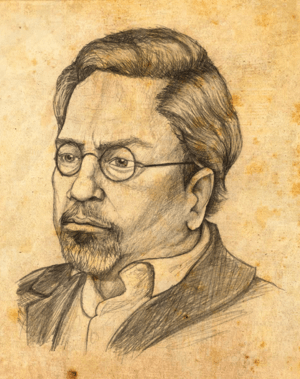Guillermo Cabrera Infante facts for kids
Quick facts for kids
Guillermo Cabrera Infante
|
|
|---|---|

Portrait of Infante
|
|
| Born | Guillermo Cabrera Infante April 22, 1929 Gibara, Cuba |
| Died | February 21, 2005 (aged 75) London, United Kingdom |
| Pen name | Guillermo Cain |
| Language | Spanish |
| Nationality | Cuban |
| Citizenship | British |
| Notable awards | Miguel de Cervantes Prize (1997) |
| Spouse | Marta Calvo (1953–1958) Miriam Gómez (1961–2005) |
| Children | Ana (b. 1954), Carola (b. 1958) |
Guillermo Cabrera Infante (born April 22, 1929, in Gibara, Cuba – died February 21, 2005) was a famous Cuban writer. He wrote novels, essays, and movie scripts. He also worked as a translator and a critic. Sometimes, he used the pen name G. Caín or Guillermo Cain for his movie work, like the film Vanishing Point (1971).
Guillermo Cabrera Infante was once a supporter of the Cuban government. However, he later moved to London in 1965. He is especially known for his novel Tres tristes tigres. This book's title means "three sad tigers" and was published in English as Three Trapped Tigers. Many people compare it to Ulysses by James Joyce because of its unique style.
About His Life
Guillermo Cabrera Infante was born in Gibara, a town in Cuba. In 1941, when he was 12, he moved with his family to Havana. This city became the main setting for almost all of his stories. His parents were among the first members of the Communist Party of Cuba.
At first, he wanted to become a doctor. But he soon changed his mind because he loved writing and movies so much. Starting in 1950, he studied journalism at the University of Havana.
He faced some challenges early in his career. In 1952, he was arrested and fined for publishing a short story that contained some strong language. He also spent a short time in jail because he was against the government at that time.
He got married for the first time in 1953. From 1954 to 1960, he wrote movie reviews for a magazine called Carteles. He used the pen name G. Caín for these reviews. By 1957, he became the editor-in-chief of the magazine, still using his pen name.
After the Cuban Revolution in 1959, he became the director of the Instituto del Cine (Film Institute). He also led a literary magazine called Lunes de Revolución. However, the government stopped this magazine in 1961.
In 1961, he got divorced and married his second wife, Miriam Gomez, who was an actress. He started to have disagreements with the Cuban government. For example, a documentary about Havana nightlife made by his brother was banned. Because of this, he was not allowed to publish his work in Cuba.
From 1962 to 1965, he worked as a cultural attaché in Brussels, Belgium. This job meant he represented Cuba's culture in another country. During this time, his feelings about the Cuban government changed. After returning to Cuba for his mother's funeral in 1965, he decided to leave the country for good. He first went to Madrid, Spain, and then settled in London, where he lived for the rest of his life.
His Famous Books
In 1966, he published Tres tristes tigres. This novel was very experimental and playful. It was full of literary references and tried to capture the many different ways people spoke Cuban Spanish. The book won an award in 1964 for the best unpublished novel.
He also helped write the script for the 1971 movie Vanishing Point. He used the name Guillermo Caín for this work.
Even though he is part of the famous "Latin American Boom" group of writers, he didn't like that label. He was always an independent thinker. He even refused to call his most famous works, like Tres tristes tigres, "novels." His writing influenced other writers from Puerto Rico and Cuba.
Awards and Recognition
In 1997, Guillermo Cabrera Infante received the prestigious Miguel de Cervantes Prize. This award is one of the most important for writers who write in Spanish. King Juan Carlos of Spain presented the award to him.
Guillermo Cabrera Infante passed away on February 21, 2005, in London. He had two daughters from his first marriage.
See also
 In Spanish: Guillermo Cabrera Infante para niños
In Spanish: Guillermo Cabrera Infante para niños

